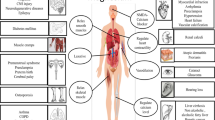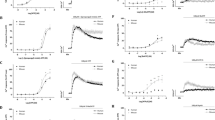Abstract
Extracellular purine nucleotides and nucleosides including ADP and ATP regulate a wide array of physiological processes including platelet aggregation, vasomotor responses and inflammation through specific purinergic receptors. In the recent years, a strong association has been reported between circulating cytoplasmic-type creatine kinase and adverse clinical outcomes such as major bleeding, hypertension and obesity. Therefore, it is proposed that extracellular CK may modulate purinergic signalling through its ADP binding and/or ATP-generating effect.

Similar content being viewed by others
References
Burnstock G (2017) Purinergic signaling in the cardiovascular system. Circ Res 120(1):207–228
Burnstock G (2020) Introduction to purinergic signaling. Methods Mol Biol 2041:1–15
Burnstock G, Ralevic V (2014) Purinergic signaling and blood vessels in health and disease. Pharmacol Rev 66:102–192
Zimmermann H, Zebisch M, Sträter N (2012) Cellular function and molecular structure of ecto-nucleotidases. Purinergic Signal 8:437–502
Yegutkin GG (2014) Enzymes involved in metabolism of extracellular nucleotides and nucleosides: functional implications and measurement of activities. Crit Rev Biochem Mol Biol 49:473–497
Taurino F, Gnoni A (2018) Systematic review of plasma-membrane ecto-ATP synthase: a new player in health and disease. Exp Mol Pathol 104:59–70
Rittiner JE, Korboukh I, Hull-Ryde EA, Jin J, Janzen WP, Frye SV, Zylka MJ (2012) AMP is an adenosine A1 receptor agonist. J Biol Chem 287:5301–5309
Brewster LM (2018) Creatine kinase, energy reserve, and hypertension: from bench to bedside. Ann Transl Med 6:292
Saks V, Kaambre T, Guzun R, Anmann T, Sikk P, Schlattner U, Wallimann T, Aliev M, Vendelin M (2007) The creatine kinase phosphotransfer network: thermodynamic and kinetic considerations, the impact of the mitochondrial outer membrane and modelling approaches. Subcell Biochem 46:27–65
Saks VA, Chernousova GB, Gukovsky DE, Smirnov VN, Chazov EI (1975) Studies of energy transport in heart cells. Mitochondrial isoenzyme of creatine phosphokinase: kinetic properties and regulatory action of Mg2+ ions. Eur J Biochem 57:273–290
Kenyon GL, Reed GH (1983) Creatine kinase: structure-activity relationships. Adv Enzymol Relat Areas Mol Biol 54:367–426
Ellington WR, Suzuki T (2007) Early evolution of the creatine kinase gene family and the capacity for creatine biosynthesis and membrane transport. Subcell Biochem 46:17–26
Deshmukh AS, Murgia M, Nagaraj N, Treebak JT, Cox J, Mann M (2015) Deep proteomics of mouse skeletal muscle enables quantitation of protein isoforms, metabolic pathways, and transcription factors. Mol Cell Proteomics 14:841–853
Meffert G, Gellerich FN, Margreiter R, Wyss M (2005) Elevated creatine kinase activity in primary hepatocellular carcinoma. BMC Gastroenterol 5:9
Wood TD, Chen LH, White CB, Babbitt PC, Kenyon GL, McLafferty FW (1995) Sequence verification of human creatine kinase (43 kDa) isozymes by high-resolution tandem mass spectrometry. Proc Natl Acad Sci U S A 92:11451–11455
Wyss M, Schlegel J, James P, Eppenberger HM, Wallimann T (1990) Mitochondrial creatine kinase from chicken brain. Purification, biophysical characterization, and generation of heterodimeric and heterooctameric molecules with subunits of other creatine kinase isoenzymes. J Biol Chem 265:15900–15908
Karamat FA, Oudman I, Ris-Stalpers C, Afink GB, Keijser R, Clark JF, van Montfrans GA, Brewster LM (2014) Resistance artery creatine kinase mRNA and blood pressure in humans. Hypertension. 63:68–73
Schlattner U, Eder M, Dolder M, Khuchua ZA, Strauss AW, Wallimann T (2000) Divergent enzyme kinetics and structural properties of the two human mitochondrial creatine kinase isoenzymes. Biol Chem 381:1063–1070
Brewster LM, van Bree S, Reijneveld JC, Notermans NC, Verschuren WM, Clark JF, van Montfrans GA, de Visser M (2008) Hypertension risk in idiopathic hyperCKemia. J Neurol 255:11–15
Brewster LM, Haan YC, Zwinderman AH, van den Born BJ, van Montfrans GA (2020) CK (Creatine Kinase) is associated with cardiovascular hemodynamics. The HELIUS Study. Hypertension, https://doi.org/10.1161/HYPERTENSIONAHA.120.14675.
Brewster LM, Karamat FA, van Montfrans GA (2019) Creatine kinase and blood pressure: a systematic review. Med Sci 7:58
Brewster LM, Mairuhu G, Bindraban NR, Koopmans RP, Clark JF, van Montfrans GA (2006) Creatine kinase activity is associated with blood pressure. Circulation. 114:2034–2039
Brewster LM, Oudman I, Nannan Panday RV, Khoyska I, Haan YC, Karamat FA, Clark JF, van Montfrans GA (2018) Creatine kinase and renal sodium excretion in African and European men on a high sodium diet. J Clin Hypertens 20:334–341
Haan YC, Oudman I, Diemer FS, Karamat FA, van Valkengoed IG, van Montfrans GA, Brewster LM (2017) Creatine kinase as a marker of obesity in a multi-ethnic population. Mol Cell Endocrinol 442:24–31
Sun G, Ukkola O, Rankinen T, Joanisse DR, Bouchard C (2002) Skeletal muscle characteristics predict body fat gain in response to overfeeding in never-obese young men. Metabolism. 51:451–456
Karamat FA, Horjus DL, Haan YC, van der Woude L, Schaap MC, Oudman I, van Montfrans GA, Nieuwland R, Salomons GS, Clark JF, Brewster LM (2017) The acute effect of beta-guanidinopropionic acid versus creatine or placebo in healthy men (ABC-trial): a randomized controlled first-in-human trial. Br J Clin Pharmacol 83:2626–2635
Karamat FA, Oudman I, Haan YC, van Kuilenburg AB, Leen R, Danser JA, Leijten FP, Ris-Stalpers C, van Montfrans GA, Clark JF, Brewster LM (2016) Creatine kinase inhibition lowers systemic arterial blood pressure in spontaneously hypertensive rats: a randomized controlled trial. J Hypertens 34:2418–2426
Brewster LM (2017) Creatine kinase: how an obsolete test for skeletal muscle disease became a risk factor for hypertension. J Pediatr 190:291
Brewster LM, Fernand JD 2019 Creatine kinase is associated with bleeding after myocardial infarction. Open Heart, in press (MedRxiv 19012039)
Wiens EJ, Arbour J, Thompson K, Seifer CM (2019) Routine creatine kinase testing does not provide clinical utility in the emergency department for diagnosis of acute coronary syndromes. BMC Emerg Med 19:37
Lindena J, Diederichs F, Wittenberg H, Trautschold I (1986) Kinetic of adjustment of enzyme catalytic concentrations in the extracellular space of the man, the dog and the rat: approach to a quantitative diagnostic enzymology, V: communication. J Clin Chem Clin Biochem 24:61–71
Brewster LM, Mairuhu G, Sturk A, van Montfrans GA (2007) Distribution of creatine kinase in the general population: implications for statin therapy. Am Heart J 154:655–661
Brewster LM, Coronel CM, Sluiter W, Clark JF, van Montfrans GA (2012) Ethnic differences in tissue creatine kinase activity: an observational study. PLoS One 7:e32471
Newham DJ, Jones DA, Edwards RH (1986) Plasma creatine kinase changes after eccentric and concentric contractions. Muscle Nerve 9:59–63
Brewster LM, Fernand JD (2020) Creatine kinase during non-ST-segment elevation acute coronary syndromes is associated with major bleeding. MedRxiv. 029108
Joo SJ (2012) Mechanisms of platelet activation and integrin αIIβ3. Korean Circ J 42:295–301
Dorsam RT, Kunapuli SP (2004) Central role of the P2Y12 receptor in platelet activation. J Clin Invest 113:340–345
Sharov VG, Afonskaya NI, Ruda MY, Cherpachenko NM, Pozin EYA, Markosyan RA, Shepeleva II, Samarenko MB, Saks VA (1986) Protection of ischemic myocardium by exogenous phosphocreatine (neoton): pharmacokinetics of phosphocreatine, reduction of infarct size, stabilization of sarcolemma of ischemic cardiomyocytes, and antithrombotic action. Biochem Med Metab Biol 35:101–114
Knudsen JB, Gormsen J, Skagen K, Amtorp O (1980) Changes in platelet functions, coagulation and fibrinolysis in uncomplicated cases of acute myocardial infarction. Thromb Haemost 42:1513–1522
Kuzmin AI, Lakomkin VL, Kapelko VI, Vassort G (1998) Interstitial ATP level and degradation in control and postmyocardial infarcted rats. Am J Phys 275:C766–C771
Fu Y, Zhu Y (2010) Ectopic ATP synthase in endothelial cells: a novel cardiovascular therapeutic target. Curr Pharm Des 16:4074–4079
Velasquez S, Eugenin EA (2014) Role of Pannexin-1 hemichannels and purinergic receptors in the pathogenesis of human diseases. Front Physiol 5:96
Cardouat G, Duparc T, Fried S, Perret B, Najib S, Martinez LO (2017) Ectopic adenine nucleotide translocase activity controls extracellular ADP levels and regulates the F1-ATPase-mediated HDL endocytosis pathway on hepatocytes. Biochim Biophys Acta Mol Cell Biol Lipids 1862:832–841
Lohman AW, Billaud M, Isakson BE (2012) Mechanisms of ATP release and signalling in the blood vessel wall. Cardiovasc Res 95:269–280
Jalkanen J, Yegutkin GG, Hollmén M, Aalto K, Kiviniemi T, Salomaa V, Jalkanen S, Hakovirta H (2015) Aberrant circulating levels of purinergic signaling markers are associated with several key aspects of peripheral atherosclerosis and thrombosis. Circ Res 116:1206–1215
Lecka J, Bloch-Boguslawska E, Molski S, Komoszynski M (2010) Extracellular purine metabolism in blood vessels (part II): activity of ecto-enzymes in blood vessels of patients with abdominal aortic aneurysm. Clin Appl Thromb Hemost 16:650–657
Sun HJ, Ren XS, Xiong XQ, Chen YZ, Zhao MX, Wang JJ, Zhou YB, Han Y, Chen Q, Li YH, Kang YM, Zhu GQ (2017) NLRP3 inflammasome activation contributes to VSMC phenotypic transformation and proliferation in hypertension. Cell Death Dis 8:e3074
Acknowledgements
None.
Author information
Authors and Affiliations
Corresponding author
Ethics declarations
Conflict of interest
LMB is an inventor on patent WO/2012/138226, an “open” non-restrictive patent request filed and published as “prior art” to protect the freedom of researchers to operate and share their innovative ideas on CK and CK inhibition without licence or payment.
Ethical approval
This article does not contain any studies with human participants or animals performed by any of the authors.
Additional information
Publisher’s note
Springer Nature remains neutral with regard to jurisdictional claims in published maps and institutional affiliations.
Rights and permissions
About this article
Cite this article
Brewster, L.M. Extracellular creatine kinase may modulate purinergic signalling. Purinergic Signalling 16, 305–312 (2020). https://doi.org/10.1007/s11302-020-09707-0
Received:
Accepted:
Published:
Issue Date:
DOI: https://doi.org/10.1007/s11302-020-09707-0




